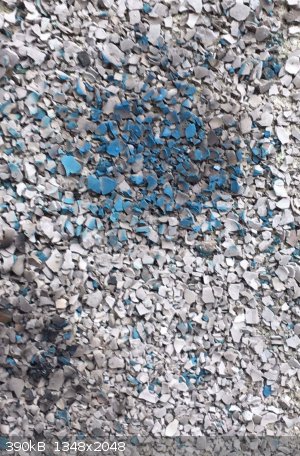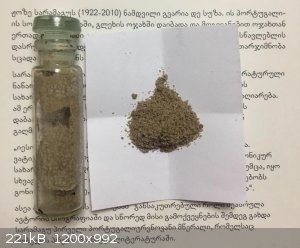| Pages:
1
2 |
vano
National Hazard
   
Posts: 661
Registered: 22-3-2019
Location: Georgia
Member Is Offline
|
|
I added ammonia solution on acid solution, white solid precipitated then it disappeared. But next i used ammonium sulfate and white salt precipitated.
I will wash and dry it tomorrow.
|
|
|
vano
National Hazard
   
Posts: 661
Registered: 22-3-2019
Location: Georgia
Member Is Offline
|
|
I made it. I heat it with small torch. But why it has blue colour? Do you know decomposition temperature?

|
|
|
vano
National Hazard
   
Posts: 661
Registered: 22-3-2019
Location: Georgia
Member Is Offline
|
|
Its look like Tungsten pentoxide.
|
|
|
Bedlasky
International Hazard
    
Posts: 1219
Registered: 15-4-2019
Location: Period 5, group 6
Member Is Offline
Mood: Volatile
|
|
It is probably some mixed W(VI)/W(V) oxide. In your mixture must be some reducing agent, I don't know what reducing agent.
|
|
|
vano
National Hazard
   
Posts: 661
Registered: 22-3-2019
Location: Georgia
Member Is Offline
|
|
I don't know. I washed powder three times.
|
|
|
Bedlasky
International Hazard
    
Posts: 1219
Registered: 15-4-2019
Location: Period 5, group 6
Member Is Offline
Mood: Volatile
|
|
Really strange. I wonder if dust can react with this thing.
|
|
|
vano
National Hazard
   
Posts: 661
Registered: 22-3-2019
Location: Georgia
Member Is Offline
|
|
I don't understand
[Edited on 14-2-2021 by vano]
|
|
|
Bedlasky
International Hazard
    
Posts: 1219
Registered: 15-4-2019
Location: Period 5, group 6
Member Is Offline
Mood: Volatile
|
|
Dust is organic material, WO3 have mildly oxidizing properties - maybe they can react with each other. Even trace amount of W(V) can cause strong blue
colouration.
|
|
|
vano
National Hazard
   
Posts: 661
Registered: 22-3-2019
Location: Georgia
Member Is Offline
|
|
Okay. Do you know acid thermal decomposition product? I have not seen anywhere, it is written that it decompose above 400 ° C and releases poisonous
gas. I can not understand why they do not write what is left and what gas is formed.
|
|
|
Bedlasky
International Hazard
    
Posts: 1219
Registered: 15-4-2019
Location: Period 5, group 6
Member Is Offline
Mood: Volatile
|
|
PH3 comes to mind with phosphotungstic acid at such high temperatures.
But we are talking about decomposition of ammonium paratungstate - there are products just WO3, NH3 and H2O.
|
|
|
vano
National Hazard
   
Posts: 661
Registered: 22-3-2019
Location: Georgia
Member Is Offline
|
|
Quote: Originally posted by Bedlasky  | PH3 comes to mind with phosphotungstic acid at such high temperatures.
But we are talking about decomposition of ammonium paratungstate - there are products just WO3, NH3 and H2O. |
No, i mean Phosphotungstic acid. Acid decomposition is easiest way, if product is useful reagent.
|
|
|
clearly_not_atara
International Hazard
    
Posts: 2696
Registered: 3-11-2013
Member Is Offline
Mood: Big
|
|
I think it is very unlikely that phosphate in any phosphotungstate salt would be reduced to phosphine by ammonia or similar NH compounds; the
electrons are basically rolling uphill. Maybe if you attempted a carbothermal reduction.
[Edited on 04-20-1969 by clearly_not_atara]
|
|
|
Bedlasky
International Hazard
    
Posts: 1219
Registered: 15-4-2019
Location: Period 5, group 6
Member Is Offline
Mood: Volatile
|
|
No, it isn't. How do you want to separate phosphate? It is much easier to crystallize ammonium paratungstate (which is far less soluble in water than
ammonium hydrogenphosphate) and decompose it.
Quote: Originally posted by clearly_not_atara  | | I think it is very unlikely that phosphate in any phosphotungstate salt would be reduced to phosphine by ammonia or similar NH compounds; the
electrons are basically rolling uphill. Maybe if you attempted a carbothermal reduction. |
But carbothermal reduction will lead also to reduction of W(VI) - so WO3 (which is desired product) won't be formed.
[Edited on 14-2-2021 by Bedlasky]
|
|
|
vano
National Hazard
   
Posts: 661
Registered: 22-3-2019
Location: Georgia
Member Is Offline
|
|
I was given old things, this is one of them. Phosphotungstic acid was in this vial It had a very old label and it was written 1958 and the name, it is
strange why it has such a color.

|
|
|
| Pages:
1
2 |